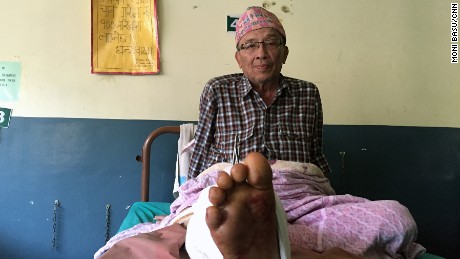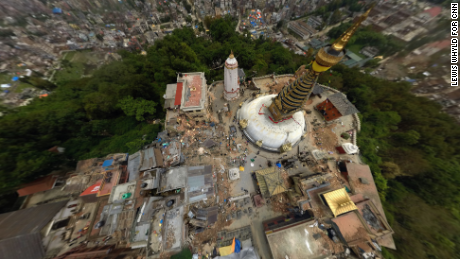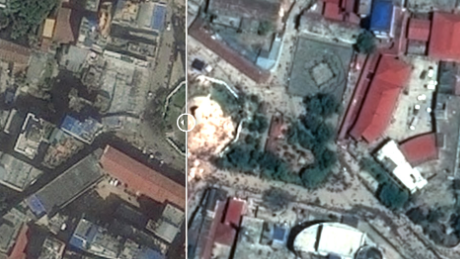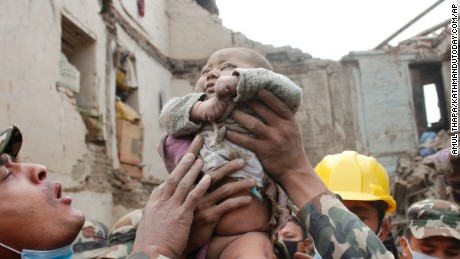Kathmandu, Nepal
From the Buddhist temple high on a hill above Kathmandu, Eric Poppleton surveys the Himalayan foothills. In the valley below is the city where his Nepal adventure began. Now, parts of it are in ruin. As are the lives of people who mattered most to him.
He braces himself for the cremation ceremony that is about to begin; he tries to keep the tears from flowing but fails. His only comfort is a conviction that he is doing the right thing.
He picks up a white silk khata, a traditional Buddhist ceremonial scarf, and drapes it over the broken body of his friend, Tom Taplin. He lights candles and incense as the priests begin their drone-like chants. Eric sits cross-legged on the floor, hypnotized by the smells and sounds.
Just a few days earlier, he and Tom stood at the base camp of Mount Everest together, feasting their eyes on nature's majesty. The longtime friends and filmmakers had laughed and talked about the documentary they were producing on the history and culture of the small tent city from where brave souls scale the treacherous mountain.
It had been an unusual spring; snow fell almost constantly for five days. Eric's boots were wet and his feet felt uncomfortably cold. He knew he had the film he needed, so when a porter showed up at base camp, Eric asked if he could trek out with him. He had less than an hour to pack his gear.
He hugged Tom and another crew member.
"I'll see you guys soon."
With that farewell, Eric made his way back to Kathmandu. He was at the airport and within minutes of departure from Nepal when the earth began heaving. A short time later, he received the terrible news.
Tom was dead.
Eric could not bear to leave his friend's body behind. This was the guy who attended the same arts college, the guy who had been climbing since he was 12 and turned Eric into a mountaineer, too. They went up the Matterhorn in the Alps and to Everest base camp. They shared meals at one another's homes – Tom owned an extendable fork with which he would randomly pluck food off his friend's plate. Together they watched slide after slide – 80 carousels worth — of their global adventures.
They loved everything about their journeys: nature, the camaraderie, the adrenaline rush. And in the end, they reveled over the absurdity of life with a few cold beers.

Eric Poppleton took this selfie with Tom Taplin, center, and John "Woody" Woodruff, right, shortly after arriving at Everest Base Camp. The three were working on a documentary about the harsh life of base camp.

This photograph, taken on April 14, captures the giant ice chunks on the mountains between Pumo Ri and the Khumbu Icefall. When the quake rocked Nepal, those ice chunks came crashing down toward Everest Base Camp.

Eric Poppleton, Tom Taplin and John Woodruff began their journey in early April in Kathmandu, where they visited historical landmarks and reveled in the everyday life of Nepal.

John "Woody" Woodruff and Tom Taplin share beer and pizza on April 10 in the tiny town of Dughla en route to base camp. Tom was nicknamed "TTap" by his friends. "Fun times over lunch with TTap," Eric Poppleton recalls.

A yak stared back along the route near Tengboche on April 6. Cable bridges are plentiful on the trail toward base camp.

Prayer flags, signifying long life and prosperity, are placed along the route from Lukla to Everest Base Camp. These flags were seen in Namche Bazaar. "They're literally everywhere," says Eric Poppleton.

Ama Dablam stands at 22,349 feet and is considered one of the most beautiful mountains in the Himalayas. Tom Taplin once summited its peak. "He was very proud of that climb," Eric Poppleton says. "This photograph is in memory of Tom."

Eric Poppleton analyzes production stills at base camp. He spent an hour interviewing Sherpas, and they enjoyed reviewing the footage with him.

Two porters carried Eric Poppleton's gear from base camp back to Lukla. Eric left the camp early; he wasn't on the mountain when the avalanche struck.

Eric Poppleton marveled at the skill of the helicopter pilots, navigating their way toward Everest Base Camp.

Eric Poppleton, pictured in the center in all black, finally made it to base camp to retrieve Tom Taplin's body. The man to his left with his arm draped around Poppleton and the man with the red scarf delivered Taplin's body to him.

As the helicopter took off from base camp, Eric Poppleton placed his hand on Tom's body. "There were tears of sorrow and joy. We still had a long way to go, but it was the beginning of the journey home."

Monks played drums, cymbals and bells at a traditional cremation ceremony for Tom Taplin on a hillside overlooking the Nepalese capital of Kathmandu.

Eric Poppleton carried Tom Taplin's body for a final time and placed it on the pyre. He'd promised Tom's wife he would document her husband's journey home.

Eric Poppleton arrived Saturday at Tom's home in Santa Monica, California, with an urn containing his friend's ashes. Tom's wife, Cory Freyer, said she felt endless gratitude toward Eric and "deep, heart-pounding emotion as I held in my hands Tom's remains."
On this evening, Eric holds absolutely no regrets about the tough decision to go back up on the mountain for his friend. Yet, as he watches the monks meticulously arrange long-stemmed carnations, gladioli and marigolds on Tom's body, he feels anxious.
He has never seen a cremation before. He cannot even imagine what it is going to feel like to watch the physical remnants of his friend burn. But he knew a cremation was the only way he could quickly reunite Tom with his wife, Cory Freyer, in Santa Monica, California. He plans to carry the ashes back himself.
After the prayers, Eric helps carry Tom's body to the pyre, stacked high with thick logs. He touches his friend one last time.
It is dark before the first flames begin to engulf the pyre. Eric, a photographer by trade, has promised Tom's wife pictures of her husband's journey home.
At times, Eric struggles to click his camera. But he believes in the importance of what he is doing, in the power and necessity of documenting life and death.
He points the camera straight at his friend's body.
"This way," he says, "I can be close forever."
Eric and Tom arrived in Nepal in early April with hopes of making a documentary that would help define Everest culture. With them was another friend, John Woodruff.
Eric is 55; Tom, 61. "Woody" is older and had undergone knee surgery – not exactly the profile of someone who might attempt a trek to Everest base camp. But Tom persuaded him to join the adventure.
"He brought a 64-year-old fat guy with two titanium knees on this trip," Woodruff said. "For Tom, it was about bringing someone he cared about."
Eric set off with Tom and Woody to make the six-day climb with more than 600 pounds of gear.
They pitched small, yellow tents at the base camp, or EBC as they called it. Eric shot with a DSLR camera, and his duty was to catch dramatic landscape and time-lapse video. In between the intense snowfall, he captured gorgeous early morning images of the sun glistening off the Khumbu Icefall, the most treacherous portion of the trek toward Everest. The frozen river is filled with deep crevasses, and immense ice hangs 10 stories tall.
His nighttime images seemed to capture every star in the galaxy peering down on Everest.
Woody shot Tom's interviews with Sherpas and mountaineers, including Dan Mazur, a renowned climber who has spent years scaling the highest peaks of the Himalayas.
Tom wanted to show how climbing Everest was once pioneering but had of late become part of the adventure travel circuit, Eric said. He also wanted to capture the unique world of mountain climbers.
"They go to these bizarre places," Eric said, "and put their lives on the line."
Eric's love of the mountains started when he met Tom in the late 1990s. Eric had walked into Adventure 16, an outdoor and travel outfitter in California, hoping to land a job conducting photographic workshops.
"Oh, you should meet my husband," said the woman who greeted him. "He does a lot of photography."
Tom Taplin was a larger-than-life guy with a warm personality and ebullient smile. When he stuck out his hand, a friendship was born.
"We've been friends ever since we shook hands – 17 years ago," Eric recalled.
Tom's fun-loving personality was instilled in him by his parents, two beloved philanthropists in Denver who dedicated their lives to helping disadvantaged children. His father, Tom Sr., helped form the Boys & Girls Clubs of Denver in 1961 and was known for making extremely generous donations, often anonymously, to the Children's Hospital Colorado and the Denver Foundation.
His dad endowed four chairs at the University of Colorado Health Sciences Center and provided scholarships to students at Denver public schools and to Metropolitan State University of Denver. His mother, Bea, continued the family's generous gifts after the family patriarch died in 2007. He was 87; the couple had been married for 55 years.
The oldest of four boys and his father's namesake, Tom shared his dad's passion – but focused it on his two loves, film and the outdoors. He supported the film department at Kent Denver School and gave sizable donations to the American Alpine Club and the Altitude Research Center Foundation. He climbed Mount McKinley; scaled Aconcagua, the highest mountain outside of Asia; and climbed Ama Dablam, one of the most beautiful peaks in the Himalayas.
He was a film student in the 1970s at the California Institute of the Arts in Valencia and the glue that helped keep a group of alums tight-knit four decades later. He built a couple of remarkable homes for himself, in Santa Monica and in Evergreen, Colorado. But publicly, Tom rarely flaunted his wealth. He drove a Toyota Camry for years and years, though he recently upgraded to a BMW.
The Everest documentary was Tom's dream project. While most stories and films have examined treks to the summit, Tom was more interested in capturing the harsh life at base camp.
That's where he was on April 25 when the glaciers began vibrating; Eric and Woody had already descended the mountain.
After a few minutes, the earth stopped moving, but the roar of an avalanche grew louder and louder. Mountaineer Jon Kedrowski wrote on his blog that no one could see the avalanche, but they knew it was coming from the thundering sound.
It was about noon. Tom was inside his tent. Three or four others at the camp took shelter behind a boulder. A massive storm of snow and ice churned toward them, and they yelled for Tom to seek shelter with them. As he emerged from his tent, ferocious gusts of hurricane-force winds spurred by the rushing avalanche threw Tom high into the air and carried his body more than 600 feet. There was nothing anyone could do.
He is among 19 people known to have died at Everest and among thousands who died in the earthquake. The death toll continues to rise by the day. Millions are injured, homeless or frightened.
But extraordinary acts of kindness emerge from the depths of disaster. And that is the story of Eric Poppleton and Tom Taplin.
Theirs was a friendship as strong as the majestic mountain they were documenting.

The Boudhanath temple in Kathmandu is one of the oldest Buddhist monuments in Nepal. Tom Taplin and Eric Poppleton visited the site on April 4. The historic temple was heavily damaged in the quake three weeks later.
On the morning of April 25, Eric awaited his flight home to Los Angeles at the airport in Kathmandu. He couldn't wait to see his wife, Blair, and 9-year-old daughter Cortez.
That's when the ground shook and jiggled like Jell-O. Eric was used to earthquakes in Los Angeles and at first he thought little of it. But when it went on and on and the shaking turned violent, Eric grabbed his passport from the checkout counter and ran with a crowd of people into the parking lot.
He made his way to the lobby of the nearby Hyatt hotel because he'd been told it was one of the few buildings in Kathmandu that could withstand a strong earthquake.
At that moment, Eric had no way of knowing the scope of the quake beyond his immediate surroundings. He emailed Tom at Everest to check his status and to let Tom know he was OK.
There was no response. Communication is always spotty at base camp. Eric clung to the hope that was the case.
But as time passed and he didn't hear back from his friend, Eric called Tom's wife in Santa Monica. She had gotten word from climber Dan Mazur via satellite phone. Tom was dead.
Eric wept. "That should've been me," he thought. He should have been right there with Tom.
He felt unfathomable grief, but he knew what he had to do. He could not leave his friend on the mountain.
He called his wife. She didn't tell him that their daughter had woken up shaking from a terrible dream.
"Daddy is covered in an avalanche," she screamed. "He's really cold, Mommy. Nobody can find him. We have to go find him."
She begged her husband not to go back to Everest. Strong aftershocks were still being felt.
"Tom knows you loved him," she said. "Please, you have family that needs you."
But deep down, she knew there was really no alternative for her husband of 12 years. He was devoted to his friend.
"I have to at least try," Eric said.
Now he needed a plan.
On his way down from base camp, Eric had met Mingma Sherpa, a young Nepalese man in the tourism trade.
Sherpa, 26, was U.S.-educated and returned home to Nepal to work with his father, who launched Himalayan Sherpa Adventure in 1992 and turned it into a lucrative business. The two had forged a new friendship over a shared lunch and their mutual fascination with photography.
"Eric here," he texted Sherpa. "A friend of mine died at base camp. Can u help?"
The response was immediate. "OK. On my way, Eric. Will be there in 15."
"K. I'll fetch my bag."
The helicopter flight from Kathmandu eastward to Lukla, the stepping off point toward Everest, takes about an hour. Eric tried to remain singularly focused on his mission to find Tom. But it was impossible to ignore the scale of destruction he could see as they flew over the area.
At Lukla, he worked his way onto another chopper to be flown to higher elevations. Eric marveled at the pilots as they navigated the jagged peaks and landed on a tiny helipad in Pheriche, where the Himalayan Rescue Association established an aid post in 1973 to help prevent deaths from acute mountain sickness.
It was Sunday, just a day after the quake. Massive search-and-rescue operations were underway to save the roughly 100 climbers trapped and injured on Everest.
The aid outpost was bustling. Rescue crews' priority was the survivors stranded at Camp 1 and Camp 2. The Khumbu Icefall had crashed down, and all routes were impassable.
In Pheriche, Eric watched the chopper pilots in awe. He called them Cowboys in the Sky. He saw them return at least 87 people safely from the two camps. He remained for about four hours before being flown back to Lukla.
Any attempt to fetch Tom would have to wait another day.
"Rescues today were priority," he texted his wife, Blair. "Dead bodies everywhere. … Base camp is a disaster, Kathmandu is a disaster. We are safe and sound. Good people here."
Eric could hardly sleep.
Seeing the destruction was overwhelming. And it still felt unfathomable that he'd lost his best friend. His grief was compounded by the major shifts in altitude he was making with no time to adjust.
He roused early Monday with a fierce determination to finish the job. Rescuers were focused on the injured, but around midday, a tiny window of opportunity opened.
He hopped aboard.
The helicopter bounced through the sky, zigzagging its way to base camp.
The timing was perfect. As they landed, "the guys from our camp were bringing Tom up."
Eric was shown the spot where his friend's body was found and given a description of what happened.
He battled survivor's guilt and altitude sickness. He tried his best not to throw up.
"I don't know. It was just – you're tired, you're not with it together in your head," he said. "You just can't be when you're popped up into high elevation. And when you're met with your best friend in a body bag …"
A flood of memories rushed back.
Tom and Eric had worked together at Everest before. They had lapped up Everest lager beer and shared wild tales. Few could tell a yarn like Tom.
Less than a week before, Eric had approached Tom outside his tent, camera rolling. "It's a beautiful morning. Misty. Magical," Tom said. "I don't know. I think I need a cigarette and a tequila." He laughed and grinned from ear to ear.
Tom had ventured into the Khumba Icefall two days before the quake and was mesmerized. "It is one of the most beautiful places I have ever seen," he messaged his wife.
It brought comfort knowing Tom died doing what he loved from "The Roof of the World," their nickname for base camp, having documented what he believed was the most spectacular place he'd ever traveled.
The helicopter slowly lifted off from base camp. It was, perhaps, the quietest and loneliest of flights.
Eric placed his hand on the brown body bag, a way of still holding on. The only identifying mark was a tag written in all caps and red pen: "Tom Taplin."
The helicopter traversed peaks and made its way back to the airport at Lukla. Eric waited for a little over an hour at a makeshift police station, where officers sat at a wobbly desk with helicopter seats and handwrote death certificates.
Helicopters dropped off 10 more bodies. A crowd of Nepalese villagers gathered – to look at the choppers flying in and out and to look at the dead.
At one point, the helicopters stopped flying and silence consumed the station. Death seemed everywhere. A BBC cameraman started filming Eric as he sat next to Tom's body. Eric told him to stop.
As he gathered his thoughts, police asked him to identify Tom. He unzipped the bag and stared at his friend for about 10 seconds.
His mind flashed back 30 years, to the day he lost his only sibling, Lisa, in a boating accident in Indiana. She was just 21. Eric had been asked to identify her body.
Now, it was more than he could bear. Eric took off running, the image of Tom burning in his brain.
When he stopped, he messaged Tom's wife, Cory, and brother, Frank. "I cannot call out right now from Lukla. I have Tom."
Soon, the two friends were on a cramped flight bound for Kathmandu. The helicopter flew through low clouds shortly after takeoff. As they crossed one mountain peak, there was a burst of sunlight.
At the Kathmandu airport, an ambulance rushed Tom's body to a morgue at the U.S. Embassy to be prepared for cremation.
Eric texted his wife: "We did it."

Memorial candles are lit at a traditional cremation ceremony for Tom Taplin on a hillside overlooking the Nepalese capital of Kathmandu.
It's quiet at the cremation grounds on the hill above Kathmandu, except for the occasional truck and motorcycle horn. And now, the crackling of kindling on the funeral pyre.
A mist has fallen over the valley, and a hazy sadness hangs in the air.
The U.S. Embassy in Kathmandu helped arrange the Buddhist ceremony because the Vietnamese-American family of another victim, Vinh Truong, requested one. Six other Americans are attending the ceremony. They do not know the dead, but Truong has no family or friends here in Nepal. The Americans say they cannot let a compatriot be given last rites without bearing witness.
Eric clutches his camera and squats near the pyre. Occasionally, he takes a picture. More often, he dries his eyes and tries to calm himself. Five days after the earthquake, this is the first time he's had time to stop and process what happened to his best friend.
He is anxious to carry Tom's ashes home to his wife. She had planned to return to their home in Colorado but is waiting in Los Angeles for Eric's arrival.
The body will take hours to burn. As the flames flicker higher, Eric takes a deep breath and looks out over a ledge at the foothills of the Himalayas.
"I don't know if I believe in an afterlife, but it sure seems like Tom is spreading himself out," he says, watching the smoke from the pyre waft out over the valley, mingling with the mist, becoming one.



